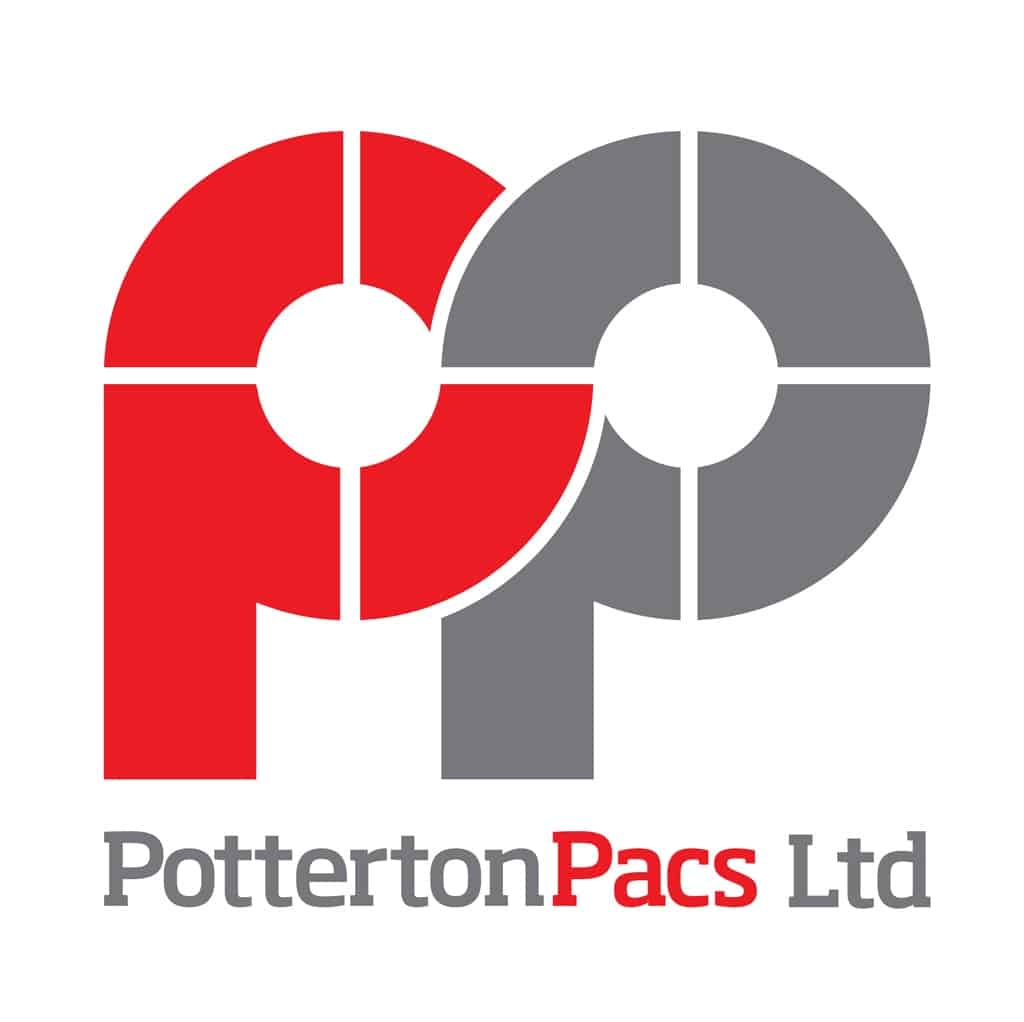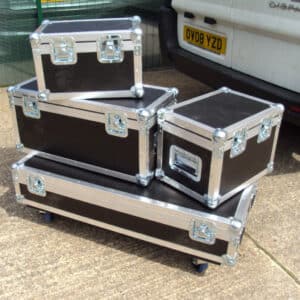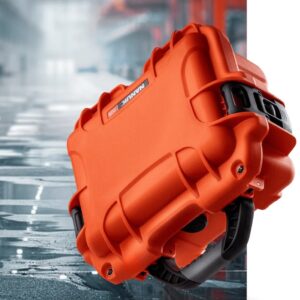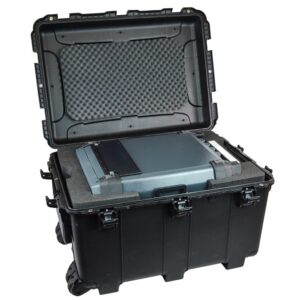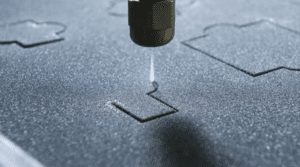If you’ve read our previous article on foam conversion services, you’ll most likely understand the basics of foam conversion and how we produce high volume precision cut foam inserts to hold and support your valuable equipment or promotional sample products.
With a wealth of knowledge from the decades of experience gained working as foam converters, our custom foam cutting processes and machinery enable us to provide superior protection, presentation and organisation solutions for packaging inserts, interiors for equipment carry cases or sales display or demo kit cases.
Our expertise in bulk foam production ensures that your business receives consistently high quality, accurately cut foam inserts tailored to your exact specifications.
The foam main four methods of foam conversion to produce custom foam inserts are band knife cutting, CNC routing, water jet cutting, and die-cutting. Each method offers unique advantages for creating precise, custom foam inserts. Let’s explore these cutting-edge technologies in detail.
Foam Sheet or Pads
Our precision manufacturing begins with large foam blocks or sheets depending upon the type of foam material selected. The transformation begins on our specialised large moving bed band knife. Using this specialist foam conversion equipment, we begin by converting the foam block by slicing the required depth of sheet from the blocks to create the sheets.
CNC Cutting: Precision Through Computer Control
Computer Numerical Control (CNC) routing provides major advantages in the production of precision foam cutting technology without the need of expensive tooling. Fully computer-controlled, by using CAD (Computer-Aided Design) is used to route shapes into foam to create custom recesses for each individual product with accurate precision. Plastazote (polyethylene closed cell foam also known as PE foam) is the most widely recognised type of foam selected to be CNC routed. Plastazote foam produces highly durable single or dual colour foam inserts for boxes, cases, drawers or trays. This sophisticated method excels in:
- Creating complex custom foam designs
- Maintaining consistent quality in bulk production runs
- Achieving varied cutting depths within a layout with exceptional accuracy
- Scalability for large-quantity manufacturing
The CNC Routing Process
CNC Routing Design & Specification:
To prepare for CNC Routing, we first create the design using a specialist CAD drawing package. The to scale drawing factors in the precise measurements of your products for optimal fit as well as any adjustments needed due to the selected material type. A drawing is supplied for the proposed layout at this stage to be signed off prior to production.
CAD Progamming for CNC Routing:
The next step is creating the programme which tells the machine both the cutting path and which tools to select to produce the foam routings whilst ensuring optimal efficiency. This is usually a combination of rough cut tools (for initial shaping) and cleanup tools (for finishing) to tidy up the cuts afterwards, giving a clean and professional finish.
CNC Routing Production & Quality Control:
Now that the CNC router is set up, the tools have been chosen, and the design has been placed on your CAD software. We’re ready for the next step, which is cutting. An off-cut is often used as a test cut before we cut into the actual chosen foam. This test cut allows us to monitor the CNC router at all times to ensure that everything runs smoothly with the programme and to test if the fit is satisfactory for all items cut into the foam layout. The final stage is to finish off by going over the foam with a final cleanup tool.
Waterjet Cutting
Used as an alternative to CNC routing, waterjet cutting has become the fastest-growing advanced precision method to cut intricate shapes into foam inserts even with the sharpest design detail, as it offers an accurate cut without interfering with the original structure of the foam. Using an ultra-high-pressure jet of clean water to cut the foam producing a hair thin, highly accurate cut at up to four times faster than the speed of sound. The process delivers precision cutting without material distortion and is another process where tooling origination is avoided making it ideal for the smallest of production runs through to economy up-scaled bulk requirements.
Process Overview
Design Specification & CAD Programming:
Similar to CNC routing, waterjet cutting works by adding the dimensions and the shape of the desired cut and the order of cutting to a CAD program. A scale CAD drawing is supplied for the proposed layout to provide visual representation of the proposed custom foam solution and allow any final tweaks prior to production beginning to be implemented.
Waterjet Cut Production Differences to CNC Routing:
A very significant difference of waterjet cut foam to CNC routed foam is the cut is all the way through the chosen foam material. A complete foam backer can be attached to the back of the foam to create a liner like boundary between the case or box inner if all of the cut outs within the foam pads are the same depth. Alternatively foam layouts that require various depths to the recesses cut within the foam would have the depth of the shaped cut out reduced and reinserted back into the cut foam pad to create various recesses to hold items of various sizes all at the same level for optimum presentation.
An advantage of waterjet cutting over routing would be the fine precision beam that creates the cutouts are not restricted to tool sizes and can achieve narrow slots and sharp curves as well as tight right angled corners as opposed to routing which can only produce radius corners.
Plastazote and other polyethylene (PE) block foams are the most commonly selected foam materials chosen for custom waterjet cut foam inserts due to the closed cell water resistant properties of these types of foam which are available in various colour and density options.
Die-Cutting: Efficiency in Repetition
Die-cutting excels in high-volume production scenarios where consistent reproduction of specific shapes is required. Commonly the most efficient method for high volumes, repetitive production. This process is ideal for protective packaging inserts for businesses requiring bulk volumes of foam inserts with consistent shape and size.
Die-Cutting Process
Press cut to desired shape and size:
The process press cuts component shapes into foam using a specialist cutting knife, which has to be created using specially fabricated blades. The blades are inserted into a plywood block to create the perimeter outline of the products or components to be held in the foam.
Using a knife/tool to stamp the foam on a large hydraulic flatbed press. Die cutting produces consistent quality, stamping all cut-outs in one single press.
An initial tooling origination cost is incurred to create the knife but once created this can be repeatedly used for any subsequent orders making it a very cost effective option for orders likely to regularly repeat at high volume.
When different depths are required within the recesses for the various cutouts the shaped cut out will be reduced in depth and placed back into the foam or a foam pad backer can be added if all cuts are required at the same depth.
Concavity can be an issue with this process, the degree of this is dependent on the density of the material as well as the thickness and number of cut outs on the knife.
High-volume production runs:
Die cutting tools (dependent upon size) can also have multiple layouts on the one knife so multiple inserts or pads can be produced in one single press cut. It’s the perfect tool to use when designing promotional materials or packaging foam solutions for larger quantities.
Concavity can be an issue with die cutting foam, the degree of this is dependent on the density of the foam as well as the thickness and number of cut outs on the knife.
Choosing Between CNC Routing, Waterjet Cut or Die Cut Foams?
All foam conversion processes have pros, cons and key factors to be considered, if you are unsure which method is most suitable for your custom foam requirement get in touch and we can guide you through finding the most suitable solution for your custom foam requirement.
Pre production samples, proto-types or pilot test batches are also approaches that can be accommodated with most of our custom cut foam solutions.
How can PottertonPacs help you?
Get in touch with a member of our team to discuss how we can help you create end caps, economy packaging foams or protective equipment or sample case foam inserts. We will walk you through the process helping you find the perfect foam solution for you and your specific business needs.

